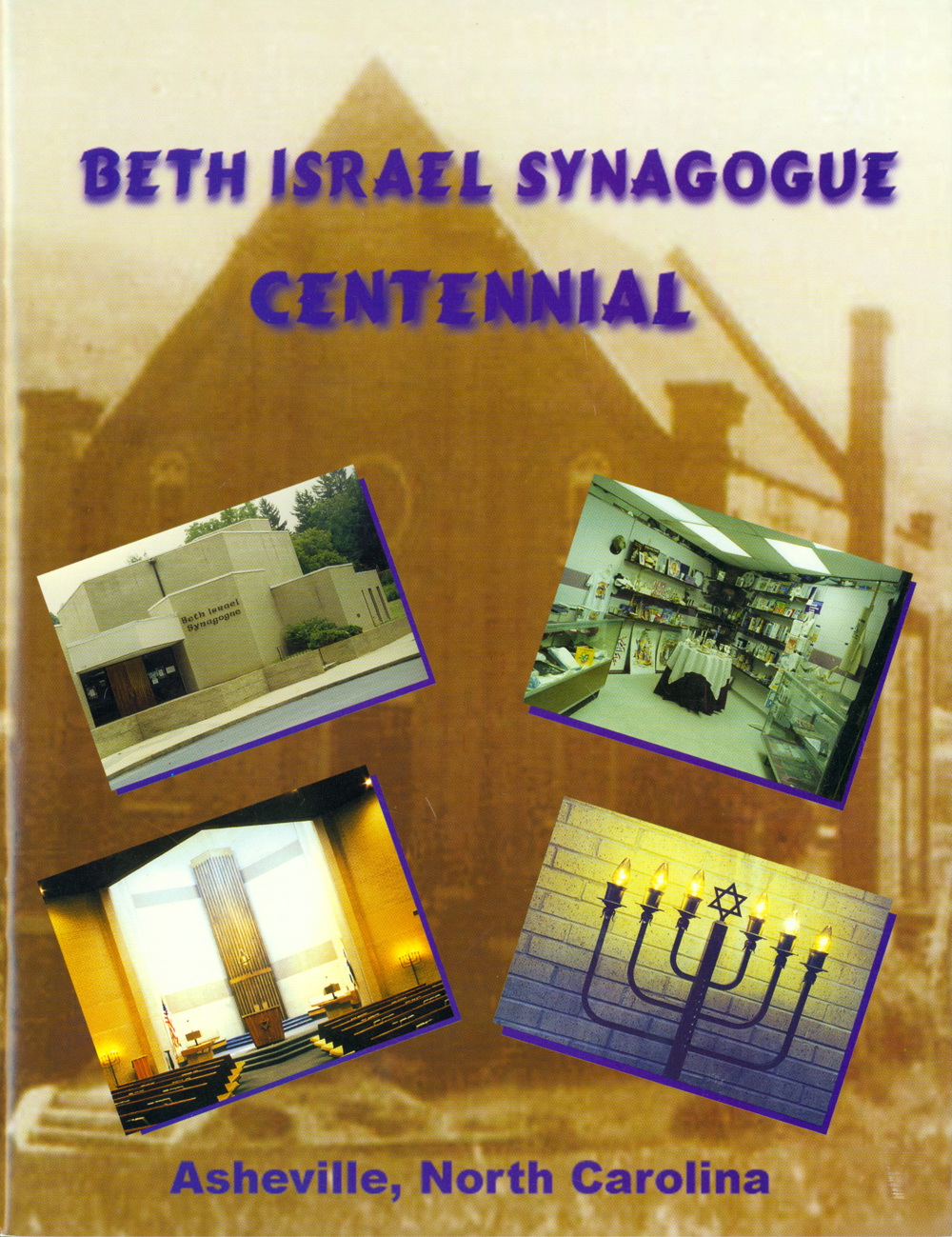|
Contents |
| Page number |
Item number |
Description |
Thumbnail |
| Cover |
biscn_001 |
Beth Israel Synagogue Centennial
Asheville, North Carolina |
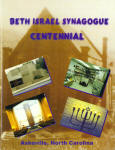 |
| Page 1 |
biscn_002 |
THE RABBI'S MESSAGE
Shalom Haverim, Shalom Friends,
I am honored to be invited to share my thoughts with you on this glorious
and hundredth year of Beth Israel's history. And I am honored to be
celebrating my tenth year at Beth Israel Synagogue. It has been a very
good match.
I write to you on the first day of spring which is also the fourth day of
the Hebrew month Nisan. These two dates, the beginning of spring
and the month of Nisan, are signs and reminders for us. They remind
us of the upcoming rebirth of nature, a miracle that happens every spring,
and the celebration of a miracle that happened in Mitzrayim (Egypt)
nearly 3,500 years ago. The miracle of Pesach reminds us that redemption
did take place in the past and will again in the future. Pesach is a sign
letting each of us in on the great divine secret: If we call out to God we
can find strength to change our lives; that God has planted within us a
soul that can move mountains.
And we have some mountains to move. As we look to our past 100 years, we
are perforce meant to look to our next century. That our next century
begins with a new millenium of world history only makes the timing more
crucial.
We have done wonders for a small Shul in a small Southern town. In our
history one can read of great and dedicated leaders (professional and lay)
who changed the direction of traditional Judaism in Western North
Carolina. Countless individuals made great sacrifices, to build a Shul in
the mountains. We would not be here but for their love of Torah and
Judaism: Rabbis, Shul Presidents and Board members, teachers, Life
Members, endowers, and all the hundreds and hundreds of members who have
lived during our 100 years.
We can be very proud of what we've accomplished, yet still acknowledge
that there are mountains yet to conquer. The following are just two peaks
in the range of possibilities. In the last ten years our beloved Shul has
more than doubled in membership. As a result, on a typical Sunday morning,
all of our classrooms are filled; another class meets in our Goldstein
Chapel; another class meets in the social hall; additionally adult Hebrew
students meet in our sanctuary. As has been noted from time to time at
board meetings, we need to grow our physical plant, as we have grown our
Shul membership.
We have also reached the time when we need another professional on the
Shul staff, one with a degree in Jewish Education and Programming to
assist us to become what we are meant to be. This, too, has been a topic
among Shul leadership for years.
As we enter our second century, it is time for us to rededicate ourselves
and grow into the glorious Shul we are meant to be, thereby giving honor
to those who came before us.
Please consider these words from our Siddur (p.509) "Rabbi Elazar
taught in the name of Rabbi Chanina: Disciples of the sages increase peace
in the world, as it was taught by the Prophet Isaiah: "When all of your
children are taught of the Lord, great will be the peace of your
children." Don't read ('banayikh') 'your children', but ('bonayikh')
'your builders.' "May there be peace within your walls, security within
your gates For the sake of my brothers and sisters I say: May peace reside
within you. For the sake of the House of the Lord grant God's people
strength; may the Lord bless the people with peace" (Ps.122 & 29).
Peace, love, and mazal tov! Rabbi Shmuel Birnham 4 Nisan 5759 |
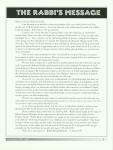 |
| Page 2 |
biscn_003 |
THE WHITE HOUSE
WASHINGTON
January 22, 1999Greetings to everyone
gathered to celebrate the 100th anniversary of Congregation Beth Israel of
Asheville.
The anniversary of a place of worship is a testament to the lasting faith
of a community. This faith is a covenant that binds members of a
congregation together in a spirit of fellowship.
Our country was founded on a great tradition of religious liberty. This
freedom helps to unite our nation of diverse faiths and creeds and gives
us common ground for tolerance and understanding of others.
Your precious faith and freedom come with great responsibilities. This
celebration is a reminder of the ways that God's gifts can be used to
fulfill our obligation to help others.
Best wishes for a memorable ceremony and for great success in the future. |
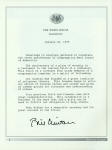 |
| Page 3 |
biscn_004 |
State of North Carolina
JAMES B. HUNT JR. GOVERNOR
CENTENNIAL CELEBRATION of BETH ISRAEL SYNAGOGUE 1999
BY THE GOVERNOR OF THE STATE OF NORTH CAROLINA A PROCLAMATION
WHEREAS, the first Jewish settlers came to Asheville in
the 1880s, attracted to the city because of economic opportunity. The year
1880 marked the long-awaited coming of the railroad to Asheville, ending
the city's isolation and bringing forth goods and passengers; and
WHEREAS, by 1891, a sufficient number of Jewish families resided in
Asheville to enable the establishment of a synagogue, and on August 16,
1891, twenty-seven of the city's Jewish citizens founded Congregation Beth
Ha-Tephila. Less than a decade later, a group of eight men decided to form
a new congregation. On February 16, 1899, Congregation Bikur Cholim
(Visitation of the Sick), as Beth Israel was called until the name change
of 1950, was chartered; and
WHEREAS, in 1911, the congregants of Bikur Cholim scraped together $1,000
to purchase a lot on South Liberty Street to build a house of worship-work
on the new synagogue proceeded slowly. The year 1916 saw the completion of
the building, but on September 16, a fire of unknown origin completely
destroyed the new synagogue. In 1924, the silver anniversary of Bikur
Cholim, the rebuilt synagogue reopened on the site on South Liberty
Street. It was to remain the home of the congregation for 45 years; and
WHEREAS, in 1959, the congregation bought a lot on the corner of Norwood
and Murdock Avenues in response to rumors that the City of Asheville had
earmarked the neighborhood around South Liberty Street for urban renewal.
When the rumors became reality, the property on South Liberty Street was
sold and a new synagogue was built and officially dedicated on May 29,
1969; and
WHEREAS, as Beth Israel began to approach its 100th birthday, the role of
women in religious services was expanded and the size of the congregation
doubled to about two hundred families. Although there have been two
synagogues in Asheville, there has actually been only one Jewish
community. Interaction among Jews within the community was made possible
by the founding in 1938 of the Jewish Community Center, where social,
recreational and cultural events have occurred. Also, the Center for
Jewish Studies at UNC-Asheville and Hadassah, the Jewish women's service
organization, have provided opportunities for interaction; and
WHEREAS, on February 20, 1999, Congregation Beth Israel will begin 100
days of celebration, a time for both reflection and resolution. The last
words that were written at the golden anniversary celebration fifty years
ago still apply today--"If we will cling to the principles and precepts of
Judaism and teach them to our children to carry on after us, our ancestors
will consider themselves well re-paid";
NOW, THEREFORE, I, JAMES B. HUNT JR., Governor of the State of North
Carolina, do hereby proclaim Saturday, February 20, 1999. as the beginning
of the "CENTENNIAL CELEBRATION of BETH ISRAEL SYNAGOGUE" in North
Carolina, and commend this observance to our citizens.
JAMES B. HUNT JR. |
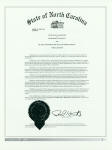 |
| Page 4 |
biscn_005 |
CITY OF ASHEVILLE
PROCLAMATIONWHEREAS, the City of Asheville,
North Carolina, is rightly known as a place of diversity and tolerance,
where all citizens, of whatever religious persuasion, race, gender,
national origin, age, handicapping condition, or other condition or
preference enjoy the fullest liberty and live together in harmony; and
WHEREAS, for well more than a century now citizens of the Jewish faith
have settled and lived in the City of Asheville and its environs, where
they have, in complete freedom, worshipped the Almighty according to the
traditions of their faith and the manner of their people; and
WHEREAS, on February 16, 1899, a small group of such citizens banded
together to charter a new Jewish congregation, Congregation Bikur Cholim,
which means "Visitation of the Sick" and which reflected the reputation of
Asheville as a place of health and of healing the sick, even in that era;
and
WHEREAS, Congregation Bikur Cholim later became known and chartered as
Congregation Beth Israel and became affiliated with the Conservative
movement of modern Judaism, as it is today; and
WHEREAS, Congregation Beth Israel is today a vibrant and thriving
synagogue of the Jewish faith, whose members have contributed much to the
life of this community and who continue to do so in such diverse fields as
the arts; the learned professions, including education, medicine, law, and
engineering; industry and retail businesses; local government; and
volunteer community service; and
WHEREAS, for all of the foregoing reasons, it is appropriate for the City
of Asheville to recognize and to honor Congregation Beth Israel on the
occasion of its hundredth anniversary;
NOW, THEREFORE, I Leni Sitnick, Mayor of the City of Asheville do hereby
proclaim February 13, 1999, as
BETH ISRAEL DAY
in the City of Asheville and would like to express my warmest and most
heartfelt congratulations to Congregation Beth Israel on this the
hundredth anniversary of its founding and express to this congregation,
its Rabbi, and the families and individuals who constitute its membership,
the hope and wish that it will continue to thrive, to grow, and to
contribute to the life of this community.
IN WITNESS WHEREOF, I have hereunto set my hand and cause the Seal of the
City of Asheville, North Carolina, to be affixed this 9th day of February,
1999.
Leni Sitnick
Mayor |
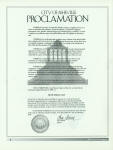 |
| Page 5 |
biscn_006 |
Our First Hundred Years
Jews first came to the mountains of North Carolina during the early
1800's. Earning their livings as itinerant peddlers, they were called
"egg-eaters" by the Cherokees because of their refusal to violate the
rules of kashrut by eating meat. The permanent Jewish population of North
Carolina grew slowly. As late as 1878 there were only 820 Jews in the
entire state, residing chiefly in such localities as Wilmington, Durham
and Charlotte.
The first Jewish settlers came to Asheville in the 1880's. It has been
said that they were attracted to the town because of former Governor
Zebulon B. Vance. This Civil War hero and native son of Buncombe County
had by the 1870's established a reputation as a friend of the state's
Jewish citizens. In the 1860's he had championed a bill aimed at ending
the ban on office-holding for non-Christians in the state legislature. In
1874 Vance entered the Chautauqua lecture circuit to deliver a
well-received speech entitled "The Scattered Nation." In it he praised
Jews as a "most intelligent and civilized" people.
Probably of greater importance in attracting Jews to Asheville in the
1880's was economic opportunity. The year 1880 marked the long-awaited
coming of the railroad to the little mountain city. Ending
Asheville's isolation, the railroad brought forth goods and passengers,
opened the mountain area to tourism and offered opportunities for
storekeepers and merchants. Among the more notable of the early Jewish
merchants were Solomon Lipinsky and the Michalove
brothers. Lipinsky, who came from Richmond, Virginia, opened a department
store in 1881 and in 1889 founded Bon Marche, for many decades a leading
retail emporium on Haywood Street. In 1889 four Michalove brothers and a
sister arrived from Lithuania. At first the men worked as itinerant
peddlers, but as their situation improved they established a number of
small stores. The most famous of these was the IXL store which became an
Asheville institution known for its fine china, glass and silver.
By 1891 a sufficient number of Jewish families resided in Asheville to
enable the establishment of a synagogue. On August 16 of that year, 27 of
the city's Jewish citizens, including Solomon Lipinsky, founded
Congregation Beth Ha-Tephila. Its charter stated that Beth Ha-Tephila was
to be a "conservative" institution dedicated to "holding religious
services, establishing a Sunday School, purchasing a cemetery and
acquiring a house of worship." (Golden Book of Memoirs: Fiftieth
Anniversary of Congregation Beth Ha-Tephila)
[image caption: Old Synagogue (circa. 1924)] |
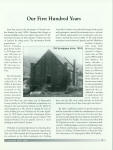 |
| Page 6 |
biscn_007 |
Less than a decade passed when a group
of eight men reached a decision to form a new congregation. What motivated
these men was their fear that Beth Ha-Tephila had strayed too far from
traditional Judaism because too many of its members had apparently come to
believe that "the Orthodox Judaism of the elders was too restrictive...and
that certain customs and traditions... were outmoded, unnecessary and too
difficult to maintain." (History of Congregation Bikur Cholim). Although
Beth Ha-Tephila had committed itself to a "conservative" form of Judaism,
its members had very likely yielded to the pressures of trying to live
comfortably as Jews in a predominantly rural section of the South where
the vast majority of their neighbors were native-born Protestants. In
addition to striving for what they regarded as respectability' in the eyes
of the gentile population, the Jewish men who established Beth Ha-Tephila
undoubtedly found strict Sabbath observance a hindrance in the quest to
earn a livelihood.
Congregation Bikur Cholim (Visitation of the Sick), as Beth Israel was
called until the name change of 1950, was chartered on February 16,1899.
Apparently those who had organized the congregation were influenced by
Asheville's reputation as a mountain health resort. The names of the eight
founders revealed that the split had divided families. Two Blomberg
brothers had been among the founders of Beth Ha-Tephila. The older
brother, Aaron, was among those who established Bikur Cholim, while his
younger brother, Louis, remained with the older congregation. Among those
establishing Bikur Cholim were J.B. Schwartzberg, M. Zageir and R.B.
Zageir, each kinsmen of Beth Ha-Tephila founders. One of the founders with
no apparent ties to the organizers of the older congregation was Solomon
Harris Michalove, one of the four brothers who had settled in Asheville in
1889. According to the Golden Anniversary history of Bikur Cholim written
in 1949, those who fifty years earlier established the new congregation
had "decided that the type of Reform Judaism emphasized at that period was
inadequate...for their needs and the needs of their children. Their answer
to the problem was the forming of a new congregation to promote and
conduct Orthodox religious services."
As the new century dawned it was not at all evident that Asheville with
its small Jewish population could sustain two congregations. Neither could
afford full-time rabbis. Bikur Cholim hired Louis Londow who had arrived
from Baltimore in 1897. Rabbi Londow supplemented his salary by opening a
Jewish grocery store. Each congregation also struggled to raise enough
funding to build or purchase a house of worship. Not until 1902 did Beth
Ha-Tephila find a permanent home when it bought a forty-year old Baptist
church for $2,000 and converted it into its first temple. Bikur Cholim in
its earliest years held services at the Masonic Temple and later at the
Odd Fellows Hall located on Church Street.
It is likely that enough sentiment existed in the broader Asheville Jewish
community to effectuate a compromise between the "conservative" Beth
Ha-Tephila and the "orthodox" Bikur Cholim. In 1904 Dr. Solomon Schechter,
the head of the Jewish Theological Seminary in New York, arrived in
Asheville to negotiate a possible merger between the two congregations.
His efforts did not succeed. In 1908 Beth Ha-Tephila moved further in the
direction of Reform by joining the umbrella organization of Reform
Judaism, the Union of American Hebrew Congregations, and by adopting its
Union Prayer Book.
By the second decade of the century Bikur Cholim was ready to strike out
along a clearly independent path. In 1911 the congregants had scraped
together $1,000 to purchase a lot on South Liberty Street to build a house
of worship. By that year Bikur Cholim had attracted many Jewish
Ashevillians who had arrived after the pioneers of the 1880's. Such names
as Schas, Schandler, Finklestein, Pearlman, Pollock and Schochet, among
others, made their appearance on the list of members and contributors.
Work on the new synagogue proceeded slowly. Enough of the structure was
completed by 1912, however, to permit the holding of High Holy Day
services. The unfinished building also accommodated a heder for the
children of the congregants. In his memoirs Leo Finklestein, a life-long
resident of Asheville, related an amusing anecdote about an experience as
a |
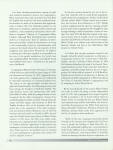 |
| Page 7 |
biscn_008 |
pupil at the heder when he was nine
years old. "In 1911" he recounted
the erection of the house of worship was started on South Liberty Street.
The Heder was moved there in 1912. Hebrew classes were scheduled every
Saturday through the winter without any heat. There was a large coal stove
in the center of the sanctuary but nobody would build a fire on Shabbos.
Even in those days educational institutions had trouble with rebelling
students. One cold day a student reported to rabbi Redunsky that a water
pipe had frozen and broke in the basement. The rabbi went to see about it.
We ran out of the building not to return until warm weather.
The year 1916 saw the completion of the building on South Liberty Street.
Then on September 16, the eve of Rosh Hashonah, tragedy struck. A fire of
unknown origin completely destroyed the new synagogue.The disaster cost
over $11,000, an enormous sum in those early days of the century.
"Of equal importance with the monetary loss," noted one commentator, "was
the realization that all the work and planning and saving of seventeen
years had vanished in smoke and flame and it would all have to be done
over again."
To add to the woes of 1916, a group of dissidents split off from Bikur
Cholim shortly after the fire. They founded a new congregation which they
called Anshei Yeshuran (Fellowship of the Upright). The records do not
reveal the reasons for the split, but in 1921 the two factions reunited.
No doubt the members of each group realized that a new synagogue could not
be erected unless they pooled their resources.
In 1924, the silver anniversary year of Bikur Cholim, the rebuilt
synagogue reopened on the site on South Liberty Street. It was to remain
the home of the congregation for 45 years. Financing the construction of
the building was a difficult task. Not until 1934 would the last of the
loans be paid off. On Yom Kippur of that year an emergency appeal to the
congregants raised the $1800 required for the final payment on the
mortgage.
Now established in their own home, the members of Bikur Cholim took on new
activities. They opened a Sunday School and a Community Talmud Torah. The
latter admitted any Jewish children who wished to attend, even those of
non-members. In 1922 a Ladies Auxiliary (now the Beth Israel Sisterhood)
was formed. It planned social activities, helped beautify the synagogue
and performed major work in fund-raising. In keeping with the name of the
congregation, the women of the Ladies Auxiliary even prepared quantities
of chicken soup for the Jewish patients at the various tuberculosis
sanitoria in the Asheville area.
[image caption: Rabbi Louis Londow] |
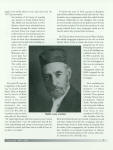 |
| Page 8 |
biscn_009 |
With the arrival of 1949 Bikur Cholim
reached its golden anniversary, celebrating that milestone at a banquet
held on February 17 at the Jewish Community Center. The featured speaker
at the festive occasion was Rabbi Gilbert Klaperman of B'rith Shalom
Synagogue in Charleston, South Carolina. Herbert Wadopian, Asheville
businessman and synagogue benefactor, served as toastmaster, while S.H.
Michalove, the only surviving member of the founding group of 1899, came
as guest of honor.
Several weeks later Bikur Cholim joined the United Synagogue of America at
a ceremony held at the Jewish Community Center. Affiliation with the
central body of Conservative Judaism officially confirmed a reality
evident for some time, namely, that Bikur Cholim was not a truly Orthodox
congregation. For many years English as well as Hebrew had been used in
services, while men and women worshipped together in mixed seating. In the
early 1950's, in a further departure from Orthodox practice, the
congregation decided to shorten the length of Sabbath services to one hour
and to start at 8AM in order to accommodate members who needed to go to
jobs and businesses. It was not until the 1970's that Beth Israel returned
to a longer Sabbath service with a later starting time. Today, the mission
of United Synagogue is to facilitate a measure of uniformity in ritual and
practice among the hundreds of congregations in the United States and
Canada which, like Beth Israel, have committed themselves to Conservative
Judaism.
A disappointing happening of the eventful fiftieth anniversary year was
the unexpected resignation of Bikur Cholim's spiritual leader, Martin
Kessler. Rabbi Kessler, a well-educated man with a science background, had
arrived in Asheville from England in 1948. Apparently the rabbi was
well-regarded by the congregants, for shortly after his arrival a house
was purchased as a residence for him on Annandale Avenue within walking
distance of the shul. Soon afterward Rabbi Kessler's wife came from
England to join her husband. What happened next is recounted by Milton
Lurey, a long-time leader and benefactor of the congregation, "I guess,"
recalled Lurey, "Mrs. Kessler must have been disappointed in our rabbi's
home but I recall they were showered with house warming gifts. Although
she was well received, she just wasn't happy, so there goes Rabbi and Mrs.
Kessler in 1949."
Rabbi Kessler's brief tenure signified what appeared to be a relatively
high rate of turnover for rabbis during Bikur Cholim's history. Kessler
had been the congregation's fourteenth rabbi over a fifty year span. One
can only speculate as to why so many rabbis came and went so often.
Perhaps among the many possible reasons were better compensation from
larger synagogues and Asheville's isolation
from the main centers of Judaism, which made it difficult for rabbis to
feel comfortable where a rich network of Jewish institutions was lacking.
Over the years there were many extended periods when the congregation had
to make do without a spiritual leader. This no doubt posed difficulties
especially during the High Holy Days and when weddings and funerals had to
be performed. Milton Lurey related
[image caption: Rabbi Martin Kessler] |
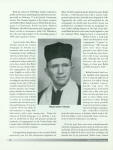 |
| Page 9 |
biscn_010 |
that at the time he wed the former
Mildred Wadopian in February of 1939 Bikur Cholim had no rabbi. Rabbi
Robert Jacobs of Beth Ha-Tephila filled in and performed a Conservative
ceremony for the Lureys. In conducting Friday night and Sabbath services,
knowledgeable laymen provided leadership. Dr. Schandler recollects that
such past members as Jake Rosen and Lou Kaplan often led services during
the 1940's and 1950's.
Beth Israel's troubles with retaining spiritual leaders continued until
1956 when Rabbi Alexander Gelberman arrived with his family from Florida.
Gelberman proved to be popular with the congregants, but in 1960 he became
ill with tuberculosis and had to be confined to a sanitarium in Black
Mountain for the better part of a year. Once again Beth Israelites had to
improvise in the absence of a rabbi. Dr. Schandler, who was the
congregation's president in 1960, remembers that Rabbi Gelberman taped his
High Holy day sermons so that they could be aired during services.
In 1964 Gelberman left Beth Israel to take a pulpit in Oak Ridge,
Tennessee. His departure during the month of August meant that Beth Israel
would be without a rabbi during the High Holy Days of that year.
November of 1965 saw the arrival of Samuel A. Friedman as Beth Israel's
spiritual leader. A native of Philadelphia, Friedman was trained as an
Orthodox rabbi. He came to Asheville after 20 years of service at
Congregation B'nai Israel in Wilmington, North Carolina. A warm and
congenial man of middle-age, Rabbi Friedman combined piety with
flexibility and erudition with affability. He was an outstanding teacher,
holding after-service discussions on Shabbos, teaching adult education
classes and leading book-of-the month gatherings at the homes of various
congregants. Also popular with the pupils of the Talmud Torah, Rabbi
Friedman prepared many for their bar and bat mitzvahs when they became of
age. In performing his duties Friedman was aided by his energetic
rebbetzin, Zehava, who played an active role in the Sisterhood. Samuel
Friedman remained at Beth Israel until 1980 when he retired after fifteen
years of service.
With the approach of the 1960's events unfolded that would lead in 1969 to
Beth Israel's move to a new home— our current synagogue at 229 Murdock
Avenue. In 1959 the congregation bought a lot on the corner of Norwood and
Murdock Avenues in response to rumors that
the City of Asheville had earmarked the neighborhood around South Liberty
Street for urban renewal. Thus, there emerged in the minds of Beth
Israelites the realization that their synagogue might be torn down and
that they would have to move elsewhere. By 1964 speculation about the fate
of the synagogue would go beyond the rumor stage. In September the
Asheville Development Commission sent Dr. Joseph Schandler a letter
stating that it had appraised the value of the
[image caption: S. H. Michalove] |
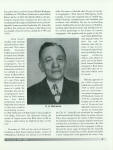 |
| Page 10 |
biscn_011 |
synagogue's building and lot at a
figure between sixty-and sixty-six thousand dollars. Undoubtedly, Beth
Israel's leaders worried over whether even the larger sum of $66,000 could
serve as a sufficient basis for a building fund campaign. In early 1967,
following negotiations between congregational leaders and the Development
Commission, the City of Asheville agreed to pay Beth Israel $88,250 for
the property on South Liberty Street. The City also agreed to delay
removal of the old synagogue until a new one could be opened for use.
These arrangements gave the green light for the start of the building
campaign. It was to be a mighty effort. The new synagogue would cost about
$225,000. With close to $90,000 received from the sale of the old
synagogue, the target of the campaign was set at $135,000. A look at the
number and variety of committees and their membership lists revealed that
practically every congregant would play some role in getting the new
synagogue built. The major committees were Building headed by Dr.
Schandler, Fund-Raising led by Jerry Sternberg and Publicity chaired by
Aaron Schandler. The overall effort was led by Beth Israel president
Benson Slosman who proudly announced at the end of May that half of the
targeted amount had been raise through pledges and actual contributions.
On December 17, 1967 the ground-breaking ceremony occurred. Rabbi Emeritus
of Beth Ha-Tephila, Sidney R. Unger, delivered the invocation, and Rabbi
Friedman conducted a brief service. Present, in addition to officers from
both of Asheville's Jewish congregations were a number of dignitaries
including Earl Eller, the mayor of Asheville, and Rev. Nilous Avery, the
vice-president of the Asheville Ministerial Association. By July 21, 1968
the construction of the new Beth Israel had progressed sufficiently to
allow for the cornerstone-laying ceremony, with a similar array of
dignitaries present.
By March of 1969 the new building was ready for use. On the last Friday
evening of March the congregation held the final service at the South
Liberty Street shul. The Asheville Citizen reported that "the seats were
packed with members of the congregation and former members who returned to
Asheville for the last services of the old synagogue." President Benson
Slosman aptly commented that "this is not a sad but a sentimental
occasion. It must be time to leave," Slosman added, for the old
synagogue's furnace had malfunctioned during the afternoon, filling the
building with smoke.
The new synagogue was officially dedicated at a ceremony held on May 29,
1969. A more spacious structure and with more amenities than its
predecessor, the Murdock Avenue building had a sanctuary with a seating
capacity of 180 as compared to the old synagogue which seated about 80
people.. Additionally, the Murdock Avenue structure had classrooms. Such
facilities were absent in the old synagogue. A happy and grateful Rabbi
Friedman offered the following prayer of blessing for the congregants
present at the dedication ceremony: "Lord of the Universe, these are the
people you have entrusted to me. They are good people. They are loyal to
your Torah. They keep your commandments.They live by your light. They are
just, kind, good, and I love them."
Succeeding Rabbi Friedman as Beth Israel's spiritual leader was Rabbi Paul
Grob who had served as a cantor in his previous post at a synagogue in
Portsmouth, Virginia. Rabbi Grob arrived with an ambitious agenda aimed at
bringing about enhanced commitment to Jewish observance and learning by
each Beth Israel member. He launched what he called a Life Long Learning
in Judaism program which involved among other initiatives a Beginner's
class in Hebrew and Jewish Values, a Bat and Bar Mitzvah program for
adults, an Independent Study with the Rabbi on Jewish topics selected by
the student and a Teacher Development program for youths over 14 years of
age to train them as future Sunday School teachers. Another initiative of
Rabbi Grob involved a merger of the Beth Israel and Beth Ha-Tephila Sunday
Schools.The apparent purpose of this venture, administered jointly with
Rabbi Paul Kaplan of Beth Ha-Tephila, was to make more efficient use of
classroom facilities and available teachers. A final noteworthy part of
Rabbi Grob's agenda was the introduction in 1982 |
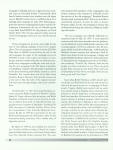 |
| Page 11 |
biscn_012 |
of daily minyans. The daily services
were intended to offer additional opportunities for torah study and to
allow those needing to recite kaddish to have a ready-made minyan.
Congregants were urged to join what came to be called the "minyanaire's
club" by attending as many week-day services as possible.
Rabbi Grob's energetic leadership quickly resulted in an impressive growth
spurt in Beth Israel's membership. Between 1980 and
1981 the number of families affiliated with the synagogue grew from 78 to
90, an increase of 15 per cent. Many of the changes promoted by Rabbi Grob
turned out to be of short longevity. The joint Sunday School venture with
Beth Ha-Tephila lasted two years and was discontinued in 1982.
Additionally, the practice of holding daily minyans could not be sustained
over time. At present, non-Sabbath minyans are held only on Thursday and
Sunday mornings. The adult bar and bat mitzvah program showed results in
1982 when septuagenarian Isabel Shulimson became the first adult in Beth
Israel's history to perform a bat mitzvah at a service during April of
that year. In subsequent years there have been additional adult bar and
bat mitzvahs at Beth Israel, several of which performed by members who had
converted to Judaism.
In 1986 Paul Grob left Beth Israel to acccept a rabbinical post in
Satellite Beach, Florida. His successor was Elliott Pearlson who at age 28
was probably the youngest rabbi in Beth Israel's history. Brought up in
Miami Beach, Rabbi Pearlson received his training at Yeshiva University in
New York and at the Talmudic University in Miami. A personable man from an
Orthodox family, Rabbi Pearlson was also a student of karate. Pearlson
explained in a 1987 interview with the Asheville Citizen-Times that his
interest in karate began while in Miami when his pride in Judaism and his
refusal to remove his yarmulke led to a number of physical confrontations.
Rabbi Pearlson's tenure at Beth Israel proved to be relatively brief. He
left in June of 1989 with his wife and young children to accept a pulpit
at a synagogue in his hometown of Miami Beach. Succeeding Pearlson was our
current rabbi, Shmuel Birnham who arrived with his wife Sara in August of
1989 in time for the High Holy Days. A native of Huntington, Long Island,
Rabbi Birnham is a graduate of Dickinson College and the Jewish
Theological Seminary. He received his ordination in 1989 upon receiving
his master's degree from the Seminary.
Rabbi Birnham quickly demonstrated a commitment to adult eduction
reminiscent of Paul Grob's Lifelong Learning in Judaism program. In the
fall of 1989 he introduced a course based on Emet Ve Emunah (Truth of the
Faith), a recently published statement of principles of Conservative
Judaism. In subsequent years the Rabbi has made teaching and learning a
central activity of his mission at Beth Israel by offering commentaries on
Sabbath Torah readings and in leading a large variety of classes with such
titles as Introduction to Judaism and Tal-
[image caption: Clockwise from top left: A. Blomberg, R. B. Zagier, M.
Schas, H. Schas. Center: L. Michalove.] |
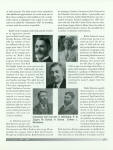 |
| Page 12 |
biscn_013 |
mud for Beginners as well as on topics
of a more advanced level.
In early 1989 the leaders of their respective synagogues began a study of
the feasibility of a merger between Beth Israel and Beth Ha-Tephila. It
seemed that history might come full circle in that the single congregation
that had divided in 1899 might become reunited now, ninety years later. In
a joint letter to their members dated March 2, 1989, Presidents William
Lewin of Beth Israel and Kerry Friedman of Beth Ha-Tephila laid out the
reasons for the possible merger. Of greatest concern was the growing
financial burden of sustaining three major Jewish institutions in
Asheville. "Ultimately," the letter asked, "can and should our community
continue to support three separate Jewish institutions" including the
Jewish Community Center? Other comments in the letter linked the possible
benefits of merger to meeting the challenges of attracting unaffiliated
Jews and of retaining professional leadership for the three major Jewish
institutions. In moving the investigation of these issues forward, each
congregation sent questionnaires to members and held special meetings to
allow congregants to air their views. A joint Merger Committee was also
formed, charged with examining all of the ramifications of the proposal
and issuing recommendations in a final report.
In regard to the matter of physical facilities, the Merger Committee
needed to consider whether to build an entirely new house of worship or to
take the more modest approach of expanding and renovating one of the
existing synagogues. Probably of even more critical importance was the
task of reconciling differences in ritual as practiced by the Reform
Judaism of Beth Ha-Tephila and the Conservatism of Beth Israel. An
eight-member Ritual Sub-Committee reached agreement on such matters as
holding Rosh Hashonah services on both days in conformity with
Conservative practice and making the wearing of kipot (skull caps) and
talilot (prayer shawls) optional rather than mandatory as a concession to
Reform custom.
The issue where no agreement could be reached revolved around defining who
is and who is not a Jew. The Reform group insisted on acceptance of the
principle of patrilineal descent which meant that the offspring of a
Jewish father and a Gentile mother could be considered a Jew without
having to undergo a formal conversion. The Conservative side, adhering to
the Halachic principle of matri-lineal descent, maintained that the
children of non-Jewish mothers did have to undergo formal conversion.
Those who did not, could not be considered Jewish and thus were not
eligible to participate in a whole gamut of rituals including bat/bar
mitzvahs, aliyot and the recitation of prayers on the bimah during
services.
With the failure to reach agreement on the critical issue of defining who
is and who is not a Jew, the merger effort came to a halt. In a report
issued in April of 1990 the Ritual Sub-Committee stated that "we
reluctantly conclude that no merger is possible at this time." The report
left open a chance for further talks in the indefinite future by
concluding that "this does not mean that there will never be a possibility
of a merger. Conditions do change, ritual practices change and the
memberships constantly change."
The abortive merger effort of 1989-1990 could not obscure a central
feature of Jewish life in the city evi-
[image captions: George Cooley
Nemiah Goldstein] |
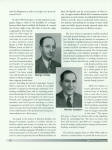 |
| Page 13 |
biscn_014 |
dent for nearly a century, namely, that
while there have been two synagogues in Asheville, there has been in
actuality only one Jewish community. In addition to the social and family
ties bringing members of each congregation together, there have existed
countless opportunities for interaction among Jews within the community's
many institutions. What initially comes to mind, of course, is the Jewish
Community Center. Founded in 1938, the JCC has sponsored events of a
social, recreational or cultural nature that for sixty years have brought
together Jews and others from the wider community. Also worthy of mention
are the Center for Jewish Studies at UNC-Asheville and Hadassah, the
Jewish women's service organization. Finally, both synagogues together
sponsor many functions and activities for youth and adults alike,
including joint Sunday School events, a Hebrew High School for post bar
mitzvah youth and the annual Yom Ha-Shoah (Holocaust Memorial) Service
held each April since 1984.
Starting in the 1980's, as Beth Israel began to approach its one-hundreth
birthday, a number of significant trends and developments became evident.
One such development was the expanding role of women in religious services
and in the sphere of synagogue governance. In the 1980's, in a move
sanctioned by the United Synagogue, women were permitted for the first
time to perform aliyot and recite haftorahs during Sabbath and festival
services. In 1987 Beth Israel selected its first woman president, Celine
Lurey. In 1996 Caren Kessler became the congregation's second female
president. A college professor and resident of Hendersonville, Ms. Kessler
has recently overseen the painstaking and important task of revising Beth
Israel's Bylaws and in general performed her duties with dedication and
distinction during her two-year tenure.
Currently women occupy positions of leadership in managing synagogue
affairs in many areas. Barbara Lewin serves as Secretary of the Board of
Directors. Arlene Schandler, formerly the long-time head the Grounds
Committee, continues to supervise the semiannual rummage sales. Doris
Abramson and Robin Landsman respectively serve as chairs of the Membership
and Family Education Committees. Shulamit Hedgepeth is chair of the Ritual
Committee and serves as a synagogue gaba'it who assists in leading
services. Ms. Hedgepeth along with Sara Birnham and Debi Miles play
leading roles as teachers and administrators in Beth Israel youth
education programs. Under the energetic leadership of Toby Cohen and
others, the Sisterhood has grown to over 100 members and continues to
undertake responsibilites vital to the well-being of Beth Israel. Ever
since the founding of the Ladies Auxiliary back in 1922 women have made
important contributions to Beth Israel, including service as members of
the synagogue's Board of Directors. Now, in this centennial year, it has
become evident that the women members of the congregation have reached a
status of parity with the male members in fulfilling practically all
phases of Beth Israel's mission.
A second major development that became increasingly striking as the 1990's
advanced was the growth spurt in Beth Israel's membership. At the opening
of the decade membership
stood at about 100 families. Presently it has doubled to about two
hundred. To a large extent this phenomenon could be attributed to a growth
spurt in the general population of Asheville and its environs. A recent
survey published in the Asheville Citizen-Times revealed that between 1990
and 1996 the population of Buncombe County increased by close to 17,000
people or by 9.7 percent. Henderson County showed an event
[image captions: Milton Lurey
Dr. Harold Book] |
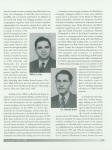 |
| Page 14 |
biscn_015 |
more impressive growth rate of 12.5 per
cent with 8,655 new residents. Undoubtedly, Jews have been well
represented in this general trend. Why Jews have moved to the Asheville
area can be attributed to the same causes explaining why others have moved
here. Asheville has a comfortable climate and scenic beauty. It is as good
place to retire or to raise a family. It also has fewer of the social and
environmental ills that plague many of our larger cities.
Another cause of the dramatic growth in membership in recent years,
unquantifiable but nevertheless palpable, is the impact of Rabbi Birnham
himself. Unlike previous spiritual leaders that have served Beth Israel,
Shmuel Birnham came from a non-observant family. By living and studying in
Israel and then attending seminary during his late twenties and early
thirties, Shmuel Birnham fashioned a strong and meaningful Jewish
identity' for himself. He not only found a religious faith but an entire
way of life rich in spiritual, emotional and intellectual fulfillment. In
the way they live and express their Judaism, Rabbi Birnham and his wife
Sara no doubt serve as beacons for those Jews who seek fulfillment in the
Tradition and who attempt to find it by affiliating with Beth Israel.
A second noteworthy feature of Beth Israel's membership is its remarkable
diversity. One can find natives and transplants, retirees and families
with children, thirty-somethings and octogenarians, couples and single
folk, Holocaust survivors and Russian emigres, Jews-by-birth and Jews-by
choice. By occupation one can list accountants, attorneys, civil servants,
crafts people, dentists, educators, health care providers, manufacturers,
optometrists, physicians, as well as realtors, retailers, restauranteurs
and retirees (many with second careers).
Diversity can no doubt cause friction and conflicts of interest among
members of a synagogue, as of any group. But diversity can also engender
fresh perspectives and new initiatives. In recent years there has been
ample evidence of the latter. Two recent transplants from Long Island,
Bill Abramson and Barry Landsberg, have done impressive work in reviving
the long-dormant Beth Israel Men's Club. Dr. Walter Ziffer, Holocaust
survivor and Judaic scholar, and Dr. Richard Chess, poet and UNC-A
professor, have enriched the spiritual and intellectual life of Beth
Israel's congregants in many ways. Rochelle Neuringer, a systems analyst
with the City of Asheville, has put Beth Israel into the twenty-first
century by creating a synagogue web-page for the Internet. In the 1980's
long-time members Jack Feingold, Abe Freedman, Benson Slosman and Ronnie
Goldstein established a Beth Israel Endowment Fund. Under the creative
leadership of William Lewin and Bob Deutsch the Endowment Fund has now
developed into an important means of helping the synagogue meet its
financial needs in a time of rapidly expanding budgetary growth.
Historians are usually wary of predicting the future. If one considers,
however, the degree of commitment to the vitality of Beth Israel and to
Judaism in general shown by the present generation of members, than one
can say that our congregation's prospects for the foreseeable future look
bright indeed. Perhaps the best way to end this account of Beth Israel's
first hundred years is to quote the last words of the golden anniversary
history written fifty years ago, hoping that a future generation can say
the same thing of us: "If we will cling to the principles and precepts of
Judaism and teach them to our children to carry on after us, our ancestors
will consider themselves well re-paid."
Author's Note: In writing this history, I was impressed by the countless
number of men and women who over the decades gave so much of the three "t's"—
time, talent and tzedakah—in furthering the well-being of Beth Israel.
Some of these good people I know of only through the written record;
others I know through personal experience as a member of Beth Israel for
nearly 30 years. Recording the contributions of all those worthy of
recognition would have required a history of at least twice the length of
the one produced in the foregoing pages. In the end I can only salute
these men and women without acknowledging them by name. In searching out
the story of Beth Israel over the span of its one hundred year existence,
I relied on many sources. Indispensible was The History of Congregation
Bikur Cholim written in 1949 |
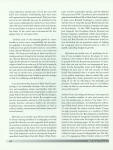 |
| Page 15 |
biscn_016 |
by an anonymous author on the occasion
of the synagogue's fiftieth anniversary. Valuable for providing historical
context especially for the early period was The Golden Book of Memoirs:
Fiftieth Anniversary of Congregation Beth Ha-Tephila (1941) and a
scholarly article by Leonard Rogoff of Chapel Hill entitled "Synagogue and
Jewish Church: A Congregational History of North Carolina." Written memoir
material by Leo Finklestein and Milton Lurey provided valuable
information, as did the personal recollections of Dr. Joseph Schandler. I
also thank Dr. Schandler for lending me a folder of his personal papers
pertaining to Beth Israel affairs. The Asheville Citizen-Times has over
the years printed many articles and reports covering the affairs of Beth
Israel as well as those of the Jewish community in general. Articles in
the Citizen-Times by UNC-A historian Milton Ready and columnist Bob
Terrell shed light on several aspects of the early history of Asheville
Jewry. I also benefited much from reading a recent article by our own Alan
Silverman enitled "Shtetele in the Mountains." It can be found on the
Jewish Community Center Web page on the Internet. Finally, essential to
fulfilling my task was the material found in the Beth Israel archives,
including a miscellany of reports, letters, announcements and pamphlets as
well as copies of the Beth Israel Synagogue Bulletin (now known as The
Shofar) dating from the 1960's to the present.
Sheldon NeuringerHappy 100th Birthday Beth
Israel
Love,
Natalie, Gary, Ethan, Samatha, Rachel, Celia and Judith Kramer |
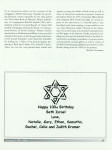 |
| Page 17 |
biscn_017 |
It's been a wonderful ten years!
Mazel Tov, Beth Israel, on your 100th.With
Love,
Rabbi Shmuel, Sara and David Shalom |
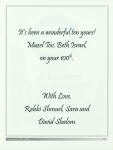 |
| Page 20 |
biscn_018 |
CONGRATULATIONS BETH ISRAEL ON THE
FIRST CENTENNIAL
From the Feingold family
Members since 1953Jack Feingold, Past
President
Norma Feingold, Sisterhood Past President
Dr. Cliff Feingold, Past President
Carol Feingold
Adam Feingold
Jamie Feingold
Steve Feingold
Joann Feingold |
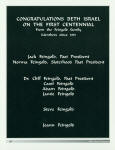 |
| Page 21 |
biscn_019 |
Lurey Family Tree
Milton Mildred
Eddie & Sandy Michael & Celine Stephen & Aimee
Diana & Brian Nicole & David
Ellen & KevinMazel Tov to Congregation Beth
Israel on it's 100th Anniversary
May it continue to grow and prosper |
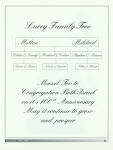 |
| Page 22 |
biscn_020 |
Dear Beth Israel,
On your One Hundredth Anniversary, we thank you for the memories of our 18
years in the congregation and for the opportunity to grow in our Jewish
practice. We fondly remember some of our highlights [in no particular
order]:
- Robin's Bat Mitzvah
- Andy's Bar Mitzvah
- High Holiday Torah Readings
- Simchat Torah unrolling of the Torah Scroll
- High Holiday Children's Services
- Being Sunday School Principal
- Teaching music at Sunday School and "The Beth Israel Rap"
- Purim Costumes and The Spiel "Who Put the Gotchkas in the Kotchke Soup?"
- The Arrival of the Birnham's
- Camp Blue Star Shabbatons
- All night Shavuot Study Sessions
- Teenage trip to the Holocaust Memorial Museum in Washington and New York
Roots Trip
- Being presidents of synagogue, sisterhood, and youth groups
- Andy leading Thursday Morning Minyanaires
- Hosting the USY Convention at our shul
You have truly been our extended family in Asheville and we look forward
to many more years together.
Love,
The Deutschim
Bob, Carol, Robin and Andy |
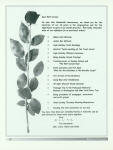 |
| Page 26 |
biscn_021 |
Congratulations to Congregation Beth
Israel on the occasion of the Centennial year of its being a vital part of
the Asheville Jewish Community.
Our family is proud to have been a part of Congregation Bikur Cholim
which became Congregation Beth Israel, having been members continually
from 1912 to this date- 87 of our 100 year history.
In 1912, David Sigmund Schandler (1885-1964) and his bride, Sarah Salem
Schandler (1888-1981) Came from Riga, Latvia to Chicago and then to
Asheville, North Carolina. Their life here resulted in the following
family:
Aaron Maney Schandler (7/10/13-10/16/81) and his wife, Shirley Lee, and
their children: Mickey (Roberta Faun) and husband Joshua Bernard Grossman
and their children, David Adam, Joel Scott and Wendy Anne Grossman.; Trudy
Anne and her husband Alvin Wong and their children, Ari Kol and Shaaron
Leesha Wong. Linda Jeanne and her husband Fred David Newman and their
sons: Jeffrey Alien, Daniel Kevin and Simon Stuart Newman.
Jack Morris Schandler and his wife, Deborah and their sons, Robert Alan
and Jon Brace with wife Amy Sue and their children Matthew Jared and Karen
Schandler.
Seymour Schandler and his wife Nancy and their children James Alien,
Steven Lee and wife Judy Ellen and their children Tracy Suzanne and
Matthew David Schandler. Susan Allison and husband David Avila
Esther Ruth Fox and her husband, Morris and their children, Judy and
husband Philip Ross Home and their children Michelle Leigh and Kevin
Austin Home. Richard Franklin Fox, wife Betsy (Mary Elizabeth) and
children, Rebecca Helen and Aaron Freeman Fox.
Herbert Yale Schandler and wife Sharron Ann and their daughters, Karen
Rebecca and Sarah Elizabeth Schandler.
Joseph Schandler and wife Arlene and their children David Kaufman and wife
Heidi, and Loren Lisa and her son, Josua Slocum |
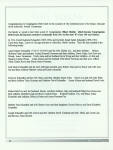 |
| Page 27 |
biscn_022 |
To Those Who Came Before Us At
Beth Israel,
Thank You For Your Vision, Your Determination and Your Legacies. One
can only imagine the struggles you faced...
Congratulations Beth Israel On A Century Of Growth, Vitality And
Purpose.
We Who Succeed You To This Day Embrace Your Steadfastness And Forge
Ahead With A Vision Of Beth Israel's Second Century:
- Fiscal Security Assured Through A Lasting Endowment
- Congregational Unity Built Upon The Strength Of Our Diversity
- Another Jewish Professional To Compliment Our Rabbi's Tremendous Efforts
- Enlarged and Improved Synagogue Facilities To Grow & Flourish Within
Will Our Children Look Back In 2099 And Celebrate Our Successes?
What Will Be Our Legacies To Our Children And Their Children?
Now Is The Time To Forge A Congregational Vision Of The Next Century Of Beth Israel.
Here's To Our Past And To Our Future!
Thank You Beth Israel For All You Do!
With Love and Friendship
Tom Rosenberg |
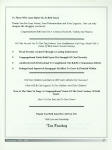 |
| Back Cover |
biscn_023 |
Beth Israel Synagogue Centennial
1899-1999Background Photo: Original Synagogue
(circa. 1924)
Front Cover: Clockwise from top to left. Current building (erected 1969),
Tekiah Gift Shop, Santuary menorah, Main Sanctuary. |
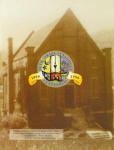 |


